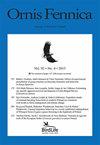受威胁的北方小黑背海鸥(Larus fuscus fuscus)的繁殖成功与乌鸦(Corvus corax)的巢穴捕食有关
IF 1.2
4区 生物学
Q2 ORNITHOLOGY
引用次数: 0
摘要
许多海鸟种群都遭受着多面手捕食者对巢穴的破坏。在这项研究中,我们分析了16年来(2005-2020年)关于挪威最大的黑背鸥种群Horsvær的北部小黑背鸥(Larus fuscus fuscus)繁殖产量的数据,这些数据与繁殖乌鸦(Corvus corax)的发生有关。2010年,在Horsvær首次发现了一对乌鸦,在2011年至2016年间,大多数年份都观察到它们与幼崽(2-5只雏鸟)在一起。2017年至2020年间,人类干预阻止了乌鸦在该群落繁殖。然而,在2020年,一对乌鸦在海鸥的孵化期中期从邻近的岛屿带着它们的雏鸟过来。平均而言,当乌鸦在研究区域内有雏鸟时,巢穴捕食率为43%。相比之下,在乌鸦繁殖不成功或缺席的年份,只有10%的巢穴被掠夺。此外,在乌鸦繁殖成功的年份,平均每个巢穴只产0.07只雏鸟,而在没有乌鸦繁殖的年份,每个巢穴产0.71只雏鸟。高水平的巢穴捕食导致筑巢海鸥的数量下降,而在邻近的无乌鸦群落中没有观察到这种情况。最后,在Horsvær乌鸦捕食率很高的几年里,附近另一个小黑背海鸥群落的雏鸟产量仍然很高。渡鸦是在春天无人的情况下在Horsvær建立的,拯救这些受到威胁的海鸥的唯一选择可能是阻止渡鸦在其栖息地或附近成功筑巢。本文章由计算机程序翻译,如有差异,请以英文原文为准。
Reproductive success of threatened northern Lesser Black Backed Gulls (Larus fuscus fuscus) in relation to nest predation by Ravens (Corvus corax)
Many seabird populations suffer heavily from the destruction of nests by generalist predators. In this study, we analyzed 16 years of data (2005–2020) on the reproductive output of the northern Lesser Black-backed Gull (Larus fuscus fuscus) at Horsvær, the largest assemblage of this subspecies in Norway (up to ca. 400 pairs), in relation to the occurrence of breeding Ravens (Corvus corax). A pair of Ravens were firstly discovered at Horsvær in 2010, and between 2011 and 2016 they were observed with broods (2–5 fledglings) in most years. Between 2017 and 2020, human intervention prevented the Ravens from breeding in the colony. However, in 2020 a pair of Ravens brought their fledglings over from a neighboring island in the middle of the incubation period for the gulls. On average, the nest predation rate was 43% when Ravens had fledglings within the study area. In contrast, only 10% of nests were depredated in years when Ravens did not reproduce successfully or were absent. Moreover, only 0.07 fledglings were on average produced per nest in years when Ravens bred successfully, compared to 0.71 fledglings per nest in years with no Raven reproduction. A high level of nest predation led to a decline in the number of nesting gulls, which was not observed in a neighboring Raven-free colony. Finally, in years with high Raven predation at Horsvær, production of fledglings was still high in yet another nearby Lesser Black-backed Gull colony. The Ravens were established at Horsvær in the absence of people in the spring, and the only option to save these threatened gulls may be to prevent the Ravens from nesting successfully in or near their colonies.
求助全文
通过发布文献求助,成功后即可免费获取论文全文。
去求助
来源期刊

Ornis Fennica
生物-鸟类学
CiteScore
2.00
自引率
0.00%
发文量
14
审稿时长
>12 weeks
期刊介绍:
Ornis Fennica is a peer-reviewed international ornithological journal published by BirdLife Finland. Ornis Fennica publishes analytical and experimental papers on the ecology, behaviour and biogeography of birds. Ornis Fennica prefers studies concerning Fennoscandian species, but other novel contributions of general interest are most welcome as well.
Ornis Fennica is an open-access journal without page charges for publication. All published articles (from 1924 onwards) are freely available from the journal website. First decisions are usually made within three months of submission.
 求助内容:
求助内容: 应助结果提醒方式:
应助结果提醒方式:


